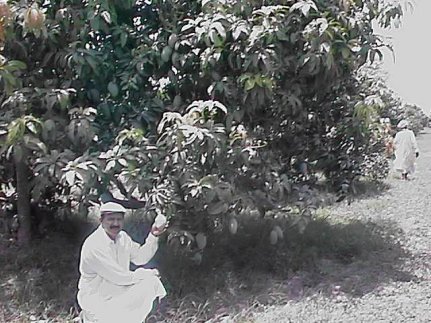
|

Irshad Gardezi next to Samer Bahest Chausa at Farm
|
|
We then
brought in few tested varieties of mango plants i.e., Samer Bahest Chausa ,Dussahri
and Fajri as these are good in quality, productivity and suitable for the local
climate of Multan (Pakistan) .The leading upto date varieties are
Langra,Chausa,dussahri and Fajri .Few new verities of mango are also being
introduced in the area which are still under trial as far as the productivity,
quality and adoptability is concerned.
We have mixed tree orchard mango
and kinnow orchard and so far the results are encouraging .
MANGO
The mango is
native to southern Asia, especially Burma, eastern India and Pakistan. It spread
early on to Malaya, eastern Asia and other countries.
The
Pakistani and Indian Mangos have less tolerance against humidity and the bright
red flushes of trees are subject to mildew.
Mangos
basically require a frost-free climate. Flowers and small fruit can be killed if
temperature drops below 40° F, even for a short period. Young trees may be
seriously damaged if the temperature drop below 30° F, but mature trees may
withstand for a very short periods in temperature as low as 25° F. The mangos
must have warm, dry weather to set fruit. In summer and following cool summer
fog as well as Wet and humid weather can cause growth of anthracnose
consequently poor fruit set after ward. Dwarf cultivation is suitable in case
more trees per acre are required Few known mango spices of trees are long-lived
as long as 300 years which are still capable of fruit production In deep soil
conditions where the taproot descends up to the depth of 20 ft and widely spread
roots system the tree may gain the height of 50 feet up. Old mango trees at the
age of 250 years are still fruiting in a farm located at a distance of 12 miles
north-east of Multan which is quite close to my mango farm.
The flowers
are yellowish in inflorescences, which appears on branch terminals. Flies, bees
act as pollinators which are responsible to maintain the cycle of nature.
Some of the
flowers in each inflorescence are perfect, so do not produce pollen and are
incapable of producing fruit. Pollen cannot be shed in high humidity or rain.
Mangos are monoecious and self-fertile. The quality of the fruit is based on the
scarcity of fiber and the taste. Some mango trees tend to be alternate bearing.Fertilization is also ineffective when night temperatures are below 55°
F.
For perfect
growth, mango tree needs a deep soil to accommodate their extensive root
systems. A pH between 5.5 and 7.5 is preferred. High Ph, soil may cause leaf tip
burn. They are somewhat tolerant to alkalinity. Mango trees require regular
applications of nitrogen fertilizer to promote healthy growth flushes and flower
production. The best available fertilizer for a mango plant is organic
fertilizer. Sandy soils require more fertilizer than loam or clay. . My
fertilizers feeding program for mangos is quite similar to one used for Kinnow
and working satisfactory. But only in early summer. Mangos may be pruned to
control size in late winter or early spring. Dead wood must be removed. Saving
big mango trees from frost damage is still unknown to me and further studies are
being carried out in that respect. Winter temperature below 30 degrees damage
leaves and twigs. Flowering and fruiting are seriously affected at temperatures
below 40 degrees during bloom. Do not prune dead parts until the frost danger is
over.
Mango fruit
matures in 100 to 150 days after flowering subject to various conditions. When
the first fruit shows ripening color on tree, the fruit of that size and over
may be removed. Do not store below 50°F.The fruit ripens best if placed stem-
end down in trays at room temperature with no air circulation so that fruit do
not get dried off from outer layer.
Irrigation,
nutrition, pest spray, weeds and grass control are the main steps to be taken to
improve the conditions for a mature mango tree.
Mango pest.
It is
important to make careful examination of trees for pest because the conditions
change each year and necessary change in spray program is required.
1. Mites:
Look for mites on upper leaf surface, along-side of midrib near terminus
of leaf
2. Scales:
Leaf surfaces( upper and lower)
3. thrips :
Lower leaf surfaces alongside the midribs
4. The
citrus mealy bug: may infest fruit and cause irregular spotting.
5. FRUIT FLY: Fruit fly is the pest which affect the fruit at ripening stage which can be controlled effectively by using Methanol/ Ugenol in traps
6.Dieback of mango trees may be due to prerce's disease (PD). No treatment exist for this bacteria. This Disease TYPICALLY kills are unproductive 2 to 3 years after infection. PD is caused by XYLALLA FASBIDIOSA Bacterium that clogs a plant XYLEM are water connecting tissues and efficiently shut down its ability to take in water and nutrition
If any articles on this site are copyright, please inform me on the above e-mail address and i will remove them immediately